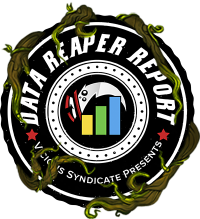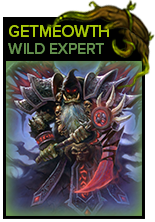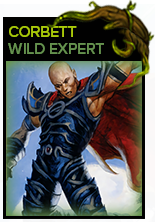
Welcome to the 31st edition of the Wild Data Reaper Report!
The data presented in this article was collected following the release of Onyxia’s Lair.
Contributing to the Data Reaper project through Hearthstone Deck Tracker or Firestone allows us to perform our analyses and to issue the weekly reports, so we want to wholeheartedly thank our contributors. Without the community’s contributions, there would be no project. Contributing data is very easy, so if you enjoy our content and would like to make sure it remains consistent and free – Sign up!
Quick Links
Class/Archetype Distribution | Matchup Winrates | vS Power Rankings | Meta Score | Class Analysis & Decklists | How to Contribute | Credits
Number of Games
| Overall | 255,000 |
| Legend | 27,000 |
| Diamond 4 to 1 | 35,000 |
| Diamond 10 to 5 | 46,000 |
| Platinum | 40,000 |
| Bronze/Silver/Gold | 107,000 |
Class/Archetype Distribution
[TABS_PRO id=56181]
The nerfs to Sorcerer’s Apprentice and Rapid Fire, as well as the latest mini set, have drastically opened the format for a diverse set of decks that are seeing play and success.
Druid is having a renaissance period in Wild, becoming the most popular class at legend, with most of it attributed to Ramp Druid variants. This archetype captures all the Wildheart Guff, Oaken Summons, Spreading Plague variants of slower Druid decks, including the new Dragon Druid, utilising Kazakusan as its primary finisher. One may think that Dragon Druid being the only “new” archetype spawning from the mini set has much to do with the popularity of the deck. While this may be a factor, the strength of the deck is playing a role. Aggressive Druid decks are also gaining popularity, with the Wild version of Beast Druid picking up traction.
Freeze Shaman remains extremely popular, as many expected. However, with the nerfs to Odd Hunter and Ignite Mage, we’ve seen a small, but notable rise in the number of Overload Shaman decks, which can breathe a little easier now that Ice Block isn’t everywhere.
Divine-Spirit Inner Fire Priest is the new Priest hotness, barely overtaking Shadow Priest as the most popular archetype for the class at legend. Shadow Priest remains more popular within Diamond ranks.
In our last report, we mentioned that Mecha’thun Warlock seemed to be one of the biggest sleepers in the format, with a measly 1% play rate. There are a few decks under the Rod Warlock umbrella: Mecha’Thun, Owl, and Togwaggle/Agony decks, and it seems that people received the message, with combo Warlocks greatly increasing in play. Even Warlock continues to be a solid, if not exciting deck for laddering as its play rate continues to hover around 2% of the meta.
Questline Pirate Warrior is the second most popular deck at legend and is by far and away the most popular deck outside of legend. The slight nerf that the questline received does not seem to have curbed many players’ desires to play the premiere aggressive deck in the format.
Questline Hunter seemed to be left for dead when its best card was nerfed, moving Rapid Fire to 2 mana, but Team 5 revitalized interest by giving the deck two extremely powerful cards in the mini set: Dragonbane Shot and Furious Howl. This has driven players very quickly to the Baku-less variant.
Rogue seems to have settled the identity crisis it was undergoing at the launch of Alterac Valley. Two prominent archetypes in Caverns Quest Rogue and Pillager Rogue have emerged. Both strategies exhibit polarized matchup spreads, but they are appealing to players.
Interest in Mage has cratered since the nerf to Sorcerer’s Apprentice. Jaina is currently going through an identity crisis, with the class completely fractured.
Paladin continues to struggle in maintaining player interest, while Demon Hunter hasn’t been relevant in Wild for over a year.
[TABS_PRO id=56182]

[TABS_PRO id=56183]
vS Meta Score
[TABS_PRO id=56184]
We can’t remember a recent time where we had such a robust set of competitive decks in our Power Rankings.
Questline Hunter leads the very close pack at higher levels. Questline Hunter may no longer be sporting an upgraded hero power, but the matchup spread remains similar, with strong matchups into slower decks and minion-based aggressive strategies.
Many players were worried when the nerf reversion to the Caverns Below was initially announced, and for the longest time, these concerns seemed to be without merit as Quest Rogue struggled to achieve anything in the format. However, the meta seems to have aligned perfectly for Quest Rogue now, and it is boasting a Tier 1 win rate. To nobody’s surprise, Quest Rogue has a very polarized matchup spread. It has extremely dominant matchups against popular slower decks such as Ramp Druid, Questline Hunter, and Rod Warlock and has brutal matchups into aggressive decks such as Aggro Druid, Shadow Priest and Questline Warrior.
Questline Warrior remains one of the best performing decks in the format. It will continue to absolutely demolish many of the “janky” decks on ladder. However, if you look at the decks in the top two tiers of the Power Rankings, Warrior just doesn’t seem to match up well against many of them. The deck is strong, but not nearly as strong as it may have looked in our previous report.
In our previous report, we mentioned Divine-Spirit Priest as another of the format’s sleeper Tier 1 decks. Sleeper no longer, DS Priest is boasting a strong win rate, thanks in large part to the deck’s absurd win rate against Questline Warrior. There is a lot to clean up within the archetype, which makes us think it can perform even better, but Divine-Spirit Priest is certainly here to stay.
Aggro Druid decks in the format are taking a page out of Standard, with Beast Druid becoming the dominant strategy for the archetype. Beast Druid utilizes Wild tools such as ‘BEEEES!!!!’ and Knight of the Wild to augment the standard-based strategy, resulting in a deck full of insanely powerful swing-turns. Beast Druid boasts a wide range of favorable matchups but would rather avoid the freeze effects of Shaman or the plethora of board clears from Warlock.
Even Warlock is loving life outside the spotlight. The nerfs took down one of its biggest problems in Odd-Questline Hunter, resulting in a robust, well-rounded matchup spread. However, Even Warlock does find itself particularly susceptible to the over-the-top, burn decks in the format, such as Shadow Priest and Overload Shaman.
The biggest surprise of Tier 1 is Even Paladin, which has seen an under-the-radar resurgence since the balance changes. Players have focused on the powerful combination of Dun Baldar Bridge and Call to Arms. With a card such as Nerub’ar Weblord, Even Paladin is a highly disruptive, aggressive deck boasting strong matchups against many of the popular decks in the format.
As we move down the Power Rankings, it’s important to note that there’s not a drastic drop off between Tier 1 and 2, and some of the Tier 2 decks exhibit Tier 1 potential post-refinement.
Ramp Druid finds itself around the top of Tier 2, with its powerful defensive tools resulting in strong matchups against some of the best decks in the format, Questline Hunter and Divine Spirit Priest. However, fast combo decks remain difficult for Ramp Druid to interact with, resulting in some horrible matchups against Quest Rogue and Rod Warlock.
Shadow Priest is the hyper-aggressive deck of the format, continuing to prey on the fragile combo decks, such as Quest Rogue, Pillager Rogue, and Rod Warlocks. By nature, it’s also very happy to see Even Warlocks who take themselves low by design. There are multiple builds of Shadow Priest emerging that find themselves with advantages in certain matchups and we’ll dive into that later.
Freeze Shaman is a very well-rounded deck, in large part thanks to its solid core allowing players to flex the final 4 or 5 slots of the deck with whatever tech cards fit their fancy. Freeze Shaman seems to be a natural place for the new neutral legendary, Blademaster Okani, to see experimentation as well. It’ll be interesting to see if it moves the needle in Freeze Shaman’s noted difficulties with Questline Hunter and Warlock decks.
We mentioned earlier that there are a few decks under the Rod Warlock umbrella: Mecha’Thun, Owl, and Togwaggle/Agony decks. Let’s be clear, only one of these should be played: Mecha’Thun Warlock. Owl Warlock and Agony Warlock are dragging down Rod Warlock’s win rate. We estimate the win rate of Mecha’Thun Warlock to mimic a clear Tier 1 deck. Rod Warlock is far stronger than it looks when optimized this way.
Rounding out our Tier 2 are a mix of underplayed, aggressive strategies in Even Hunter, Murloc Shaman, Secret Hunter, and Cute Warlock. Even and Secret Hunter have moved on from bullying APM and Ignite Mages to bullying Divine-Spirit Priests. Murloc Shaman and Cute Warlock look to punish popular decks with limited early game interaction, such as Ramp Druid, Quest Rogue, and Pillager Rogue to snowball the game in their favor.
The last of our Tier 2 decks is another surprising Paladin deck, Reno Paladin! Reno Paladin doesn’t have many super favorable matchups, but the appeal is that it also doesn’t have many unfavorable matchups either. Well-rounded, as all Reno decks should be.
Class Analysis & Decklists
Demon Hunter | Druid | Hunter | Mage | Paladin | Priest | Rogue | Shaman | Warlock | Warrior
A plethora of Ramp Druid lists using various finishers have become popular throughout ladder. In the aggregate, these archetypes are solid, however there are clear differences in the performance of specific builds.
Despite some early hiccups in refinement, Dragon Druid is the best approach for slower Druids. This deck is knocking on the door of Tier 1! Breath of Dreams had potential in Wild since its release, but the additions of Kazakusan and Raid Boss Onyxia have finally given it a home. The Twig and Sphere package also continues to perform very well in all Druid decks that can find space for it.
Dragon Druid possesses the typical strengths we’ve come to expect from defensive Druid lists but has much greater ability to counter pressure and close out games. Although Linecracker Druid remains decent and the next best approach for Ramp Druid decks, there is a difference in lethality between Dragons and Linecracker.
C’Thun, the Shattered and Celestial Alignment continue to see play, but they aren’t too worthwhile. C’Thun Druid has been supplanted by faster lists, while Celestial Druid’s unique win condition is much weaker than the alternatives.
Druid also manages to have one of the best aggressive decks in the format! Taking inspiration from Standard, Beast Druid has been popularized and looks like a Tier 1 deck across all ranks. While the deck does drop off a touch at higher levels of play, it has an impressive matchup spread, excluding its clear weaknesses to Shaman and Warlock.
Embiggen Druid is a fringe choice, mostly falling away as Beast Druid has gained more attention.
Freeze Shaman hasn’t become the absolute meta tyrant that some feared. Instead, the archetype looks good but a notch below the best decks in the format. It’s worth noting though that Freeze Shaman has very few weaknesses and remains incredibly difficult to target. Pure burn strategies are the only clear approach, Questline Hunter being the most prominent. Freeze Shaman builds continue to be varied, with players using what feels like half the total wild card pool in the flex slots. This seems unlikely to change anytime soon, given the effectiveness of the deck’s core and its ability to carry tech choices as players see fit. Blademaster Okani seems like a natural fit in the deck, and we would test it in place of one Chain Gang.
The nerfs to Ignite Mage and Odd-Questline Hunter have left Overload Shaman in a much better position than it was in previously. The deck has shot up from Tier 4 in our last report to a respectable win rate just below 50%. Players recently began tinkering with Overload Shaman, dropping Drek’Thar in favor of Giants. Although both approaches are quite close in strength, we recommend players continue using the previously established Drek’Thar builds. There is also some experimentation with adding Command the Elements to the deck, but we haven’t been able to evaluate it.
Murloc Shaman has returned after looking dead in the water. For anyone who has forgotten, the deck has a polarizing matchup spread, excelling when given time to snowball and floundering when properly contested. For this reason, it performs slightly better at legend, largely due to more Ramp Druids and fewer aggressive decks. Murloc Shaman hasn’t been given any attention from top players, leaving us to make the novel suggestion of playing Drek’Thar over Old Murk-Eye.
Drek’Thar Divine-Spirit Priest is almost certainly the best deck in the format. Sadly, we’re unable to get a perfect picture of its performance due to the much worse spell-based iterations of the deck littering the archetype.
Lists using Palm Reading and Power Word: Fortitude have a game plan primarily focused on stealing opponent’s minions to deal lethal damage. These versions of the deck are much worse but are puzzlingly popular at higher ranks. This can be highlighted in the matchup table by looking at how Divine-Spirit Priest’s win rate drops dramatically against Questline Warrior at legend. Spoiler: it’s not because of Warrior’s huge skill cap. This is entirely due to builds, as the spell-based version of the deck has a much weaker Questline Warrior matchup. Altogether, this makes the overall performance of Divine-Spirit Priest even more impressive.
Shadow Priest is also split in its build, however this time both approaches seem valid. Pirates have been the stock approach since the deck’s inception, but recent lists focused on burn have been impressive. The pirates are better in aggressive mirrors or matchups where chip damage can accumulate, such as Questline Warrior or Ramp Druid, respectively. The burn builds are stronger when chip damage and board presence are less important, such as against Warlock.
- Drek’Thar Divine-Spirit Priest
- Infantry Divine-Spirit Priest
- Cannon Shadow Priest
- Burn Shadow Priest
There are several archetypes in this report weighed down by significantly worse builds. Mecha’Thun Warlock may be the biggest victim of this, as the Rod Warlock collective includes lists that have extremely different win rates. Mecha’Thun Warlock is excellent, Owl Warlock is bad, and Agony Warlock is an abomination that should have never seen the light of day.
Mecha’Thun Warlock is a Tier 1 deck. It does have some poor matchups, which is to be expected given its gameplan. Mecha’Thun Warlock only has one goal in mind, and if other decks can execute their combo faster than the Warlock, there’s nothing it can do about it. However, Mecha’Thun Warlock is generally strong into aggressive decks, farms Druids, and there aren’t enough decks that can consistently outrace it. Owl Warlock was an attempt to flip the mirror, but in the end the list is weaker to aggro and disruption.
Even Warlock is enjoying life as various nerfs have addressed its biggest problems over the past few months. The deck has one of the cleanest matchup spreads in Wild, able to stand a good chance against almost everything except Shadow Priest. Showstopper has been popping up in Standard as a tech against Snowfall Guardian and the card has plenty of applications in Wild too.
Cute Warlock is looking its best since Forged in the Barrens. As always, we must put out a PSA reminding players that putting Zephrys the Great in the deck is a terrible idea. Cute Warlock isn’t going to be a powerhouse anytime soon, but if you’re able to dodge Shaman and Warlock, you’ll have a pretty good time.
If players feel compelled to try a Reno Warlock, we will of course suggest Even-Reno Warlock. The Genn version of the deck isn’t outstanding and has dropped significantly in popularity but is still clearly superior to the normal Reno Warlock.
Darkglare Warlock would be our suggestion for players interested in trying something off-meta. Darkglare Warlock’s play rate has never recovered since the ban of The Demon Seed, but we’re curious how it would look if it was given appropriate attention and refinement.
Questline Warrior remains one of the best performing decks in Wild. That isn’t to say the nerf to Raid the Docks did nothing. Although subtle, the change has had a significant impact, as have recent innovations and changes in the Wild landscape.
Questline Warrior’s impact at lower rank brackets shouldn’t be understated. It has the highest win rate at lower ranks of ladder, while being the most popular archetype everywhere outside legend. Its 18% play rate at upper diamond, although not historically egregious, is still double the play rate of the next most popular archetype. Even at legend, the deck continues to perform very well, placing itself at Tier 1.
However, Questline Warrior simply doesn’t line up well against the top dozen or so decks in the format, Shadow Priest and Caverns Rogue being exceptions. Furthermore, most of its matchups get worse at higher levels of play and in cases where they don’t, it seems clearly build-related (e.g., Divine-Spirit Priest and Rod Warlock). It isn’t a surprise to hear reports of Questline Warrior’s play rate dwindling at top legend.
Questline Warrior remains a hot topic for many players in the Wild Hearthstone community. However, the stranglehold it previously had on the format has loosened. We’re hopeful a more diverse experience opens for players of all levels.
It’s back! Questline Hunter took a three-week vacation after the nerf to Rapid Fire. But a few key pickups have resulted in the deck bursting back onto the scene, this time without an upgraded hero power.
Its matchup spread is very similar to what we saw previously from Odd-Questline Hunter. It excels against slower, passive strategies and aggressive decks that are highly board based and lack huge swing turns. Meanwhile, there’s very little that can be done to alleviate its problems against Rogues. Much like Mecha’Thun Warlock, Questline Hunter doesn’t have any ability to deviate from its one game plan, meaning it’s going to lose when singularly focused decks are too fast. Beast Druid, Divine-Spirit Priest, and Even Warlock can also present problems, which is why we’re recommending Hunter’s Mark in the last slots of Questline Hunter. Hunter’s Mark isn’t amazing but seems the best option to shore up these specific weak points.
There was an expectation that Even Hunter and Secret Hunter would collapse without a Mage population to pick-on. In the end, these decks are looking even better than they were last report. They are neck-and-neck in win rate, finding themselves both in Tier 2 at legend. As always, Even Hunter is much weaker against aggro, but better against control decks such as Freeze Shaman and Mecha’Thun Warlock. Divine-Spirit Priest has replaced Mage as the new highest profile victim of Hunter secrets.
It took almost an entire year, but Caverns Rogue finally broke. The matchup spread is exactly what we all remember from its time in Standard, a polarizing game of Rock, Paper, Scissors. At upper Diamond, there’s a lot of paper, so Caverns Rogue is Tier 2. Everywhere else there’s a bit more scissors, which means Caverns Rogue has one of the highest win rates in the format.
Polarization snowballs into more polarization. Decks such as Ramp Druid, Questline Hunter, and Mecha’Thun Warlock become much more polarized by the existence of Caverns Rogue, due to the possibility of queuing into a sub 30% matchup. The same is true for aggressive decks such as Shadow Priest and Aggro Druid, where the difference between seeing a Caverns Rogue compared to a Freeze Shaman is extreme.
So far, Caverns Rogue’s influence on the meta has been very light, with a population of less than 3%. However, even a small uptick in its frequency could cause drastic changes in deck win rates for dozens of archetypes. Caverns Rogue is the biggest ticking time bomb in the current Wild meta, and it looks ready to go boom. It seems hilarious to say this, but Nerub’ar Weblord might be the only thing holding the format together.
Pillager Rogue is very similar to Caverns Rogue, but weaker. It doesn’t have the benefit of decimating Druids the way Caverns Rogue does, and has a few matchups where it’s slightly weaker, such as Freeze Shaman. Pillager Rogue does demonstrate a high skill cap, but it’s not enough to make the deck a true contender.
Kingsbane Rogue has almost an identical matchup spread to Pillager Rogue, with slight improvements overall. It’s now flirting with a 50% win rate, the best it’s looked for some time.
Mage is a disaster. The nerf to Sorcerer’s Apprentice, while understandable, has killed all viable archetypes in the class. Despite plenty of interest from players, nothing looks remotely competitive. Instead, six different Mage decks land in Tier 4 in our Power Rankings. We’ve listed Wildfire Mage and Secret Mage as the best possible options.
Paladin is grossly underplayed, as always. That said, there’s been some very exciting changes in the class!
Reno Paladin is a Tier 2 deck. Yes, Reno Paladin. This list is a pile of greed and even we are a bit confused how it wins games, but it does. When Reno decks are good, they’re typically well-rounded, and Reno Paladin is no exception. It has a strong enough balance between defense and threats that most matchups don’t deviate too far from even. For a lot of people, this list may bring back feelings tied to Reno-Galaxy Mage. If that appeals to you and you have a spare credit card, give this deck a shot.
In other news, this is the first time Even Paladin has been listed as Tier 1 in Wild since Witchwood! Even Paladin has had a rather under-the-radar resurgence following Onxyia’s Lair. It excels as an anti-combo deck that also happens to be good against Questline Warrior. Dun Baldar Bridge and Call to Arms make for a powerful pairing, while Ring of Courage has been a huge new addition.
Handbuff Paladin and Odd Paladin are okay, but mediocre. They struggle against almost every top tier deck, and mostly pick off wins against weaker or experimental archetypes.
Odd Demon Hunter is very playable right now! Completely ignored, the deck is estimated to be Tier 2. Realistically, we know players aren’t going to immediately flock towards the deck. Demon Hunter is hanging out until rotation and nerf reversions.
Preparing our weekly article requires a significant amount of time and effort from many individuals. We would like to wholeheartedly thank our current Patreons, whose generous donations help us fund computing and server costs.
vS Gold and vS Silver are memberships aimed to support our efforts towards improving our content and data analysis while giving you some bonuses and extra features.
Contributors
Here are all the people that participated in bringing you this edition of the [Wild] vS Data Reaper Report:























This came out on March 20th, my friends birthday. He doesn’t play hearthstone, but I do, so this is a great gift to me on his birthday.